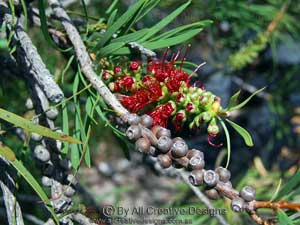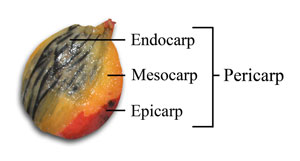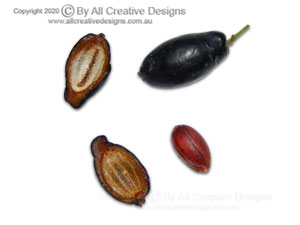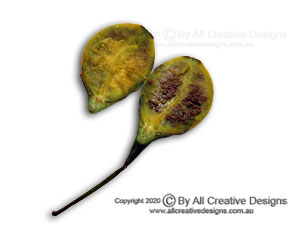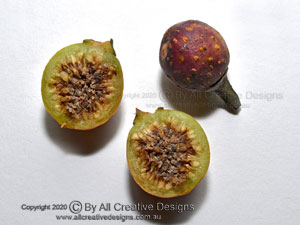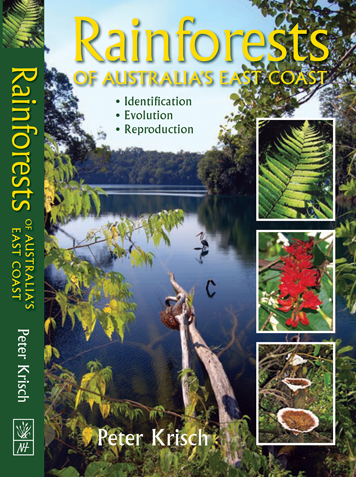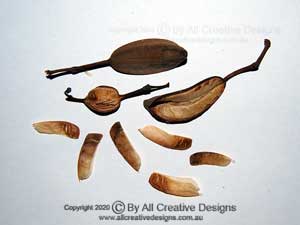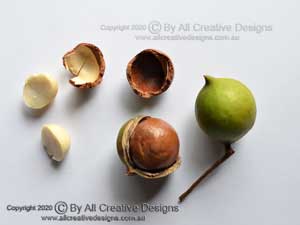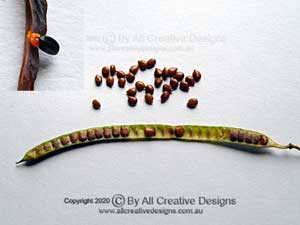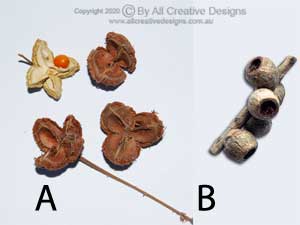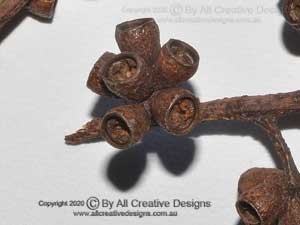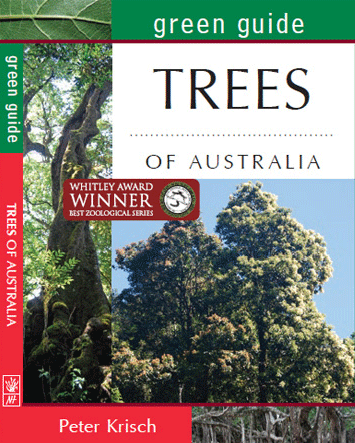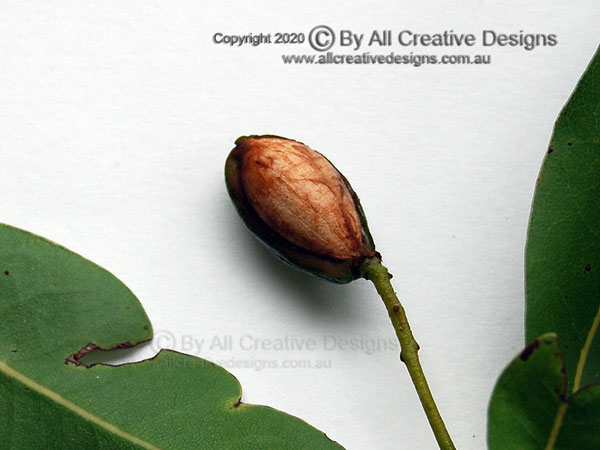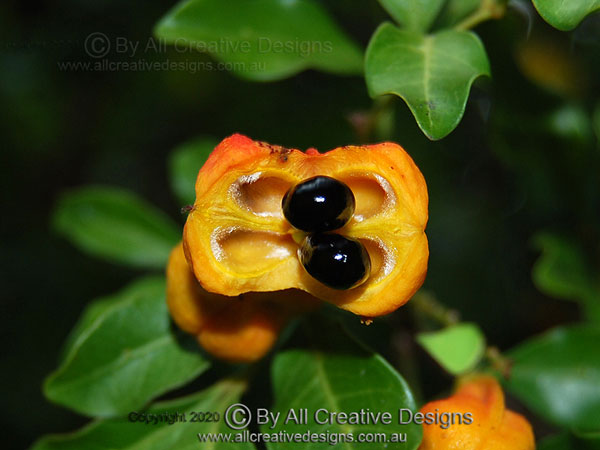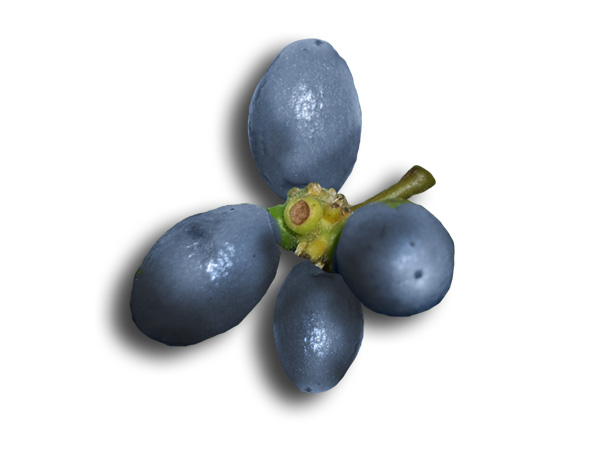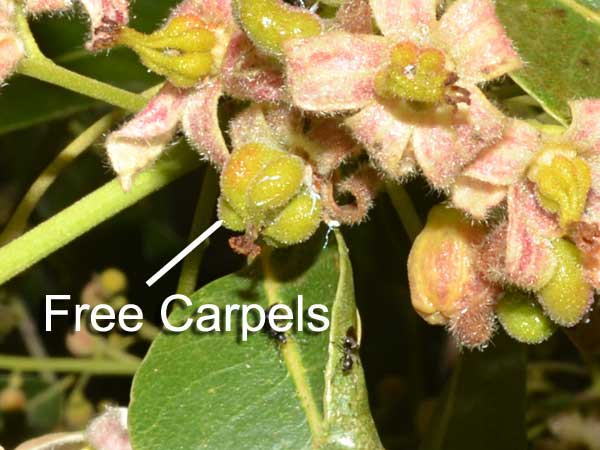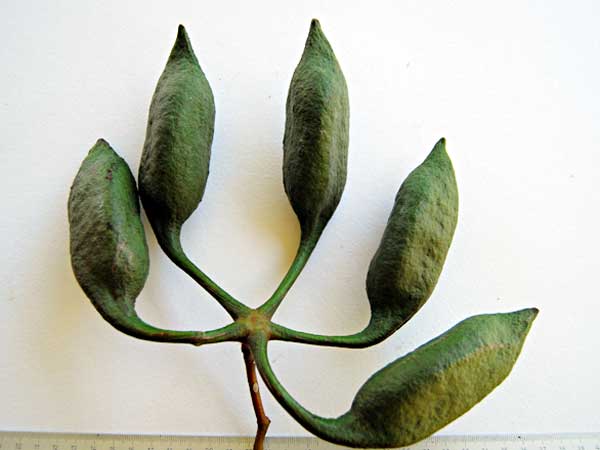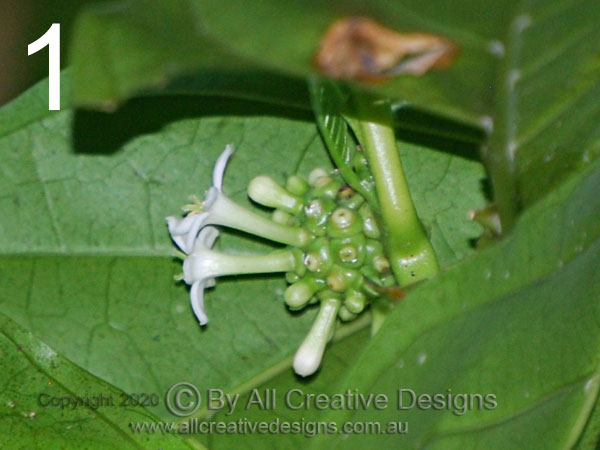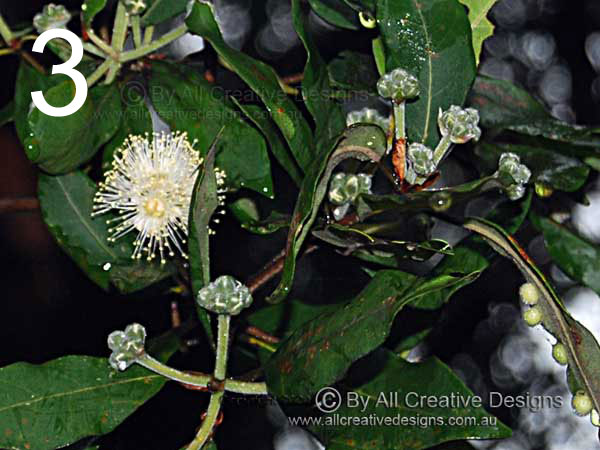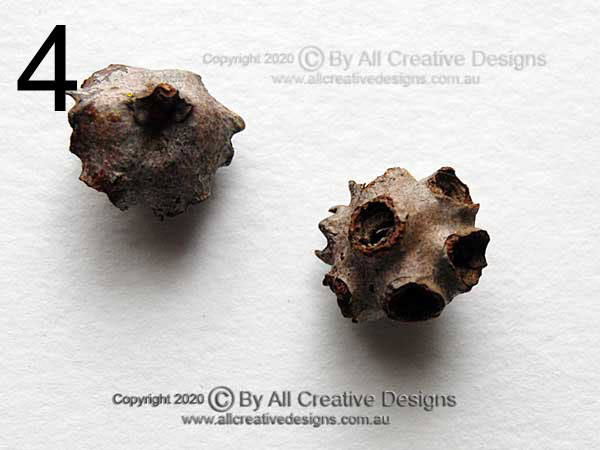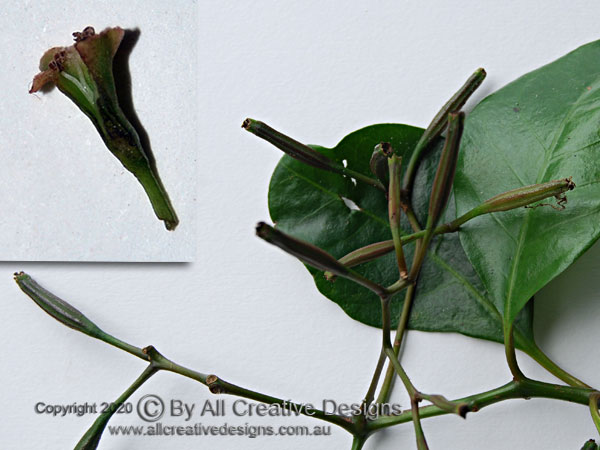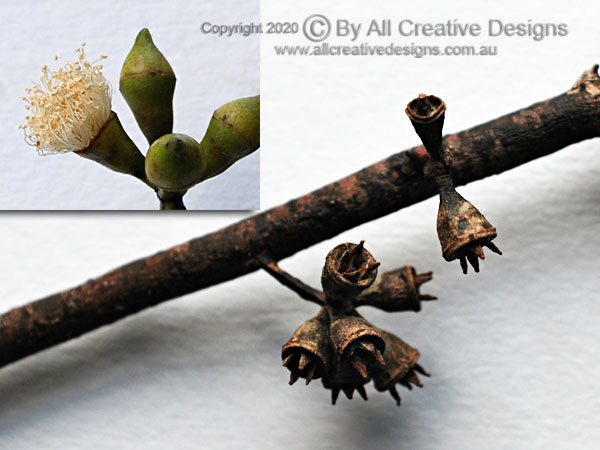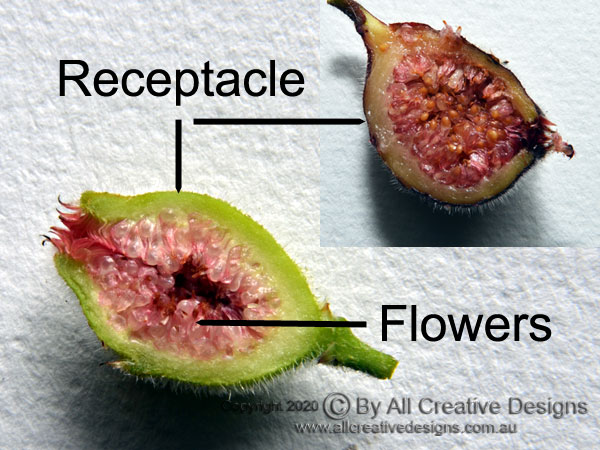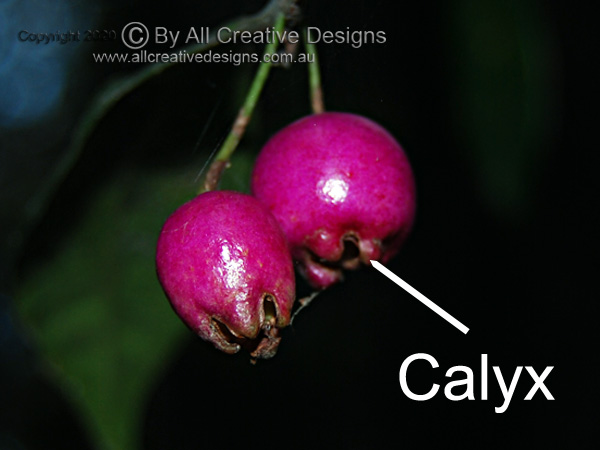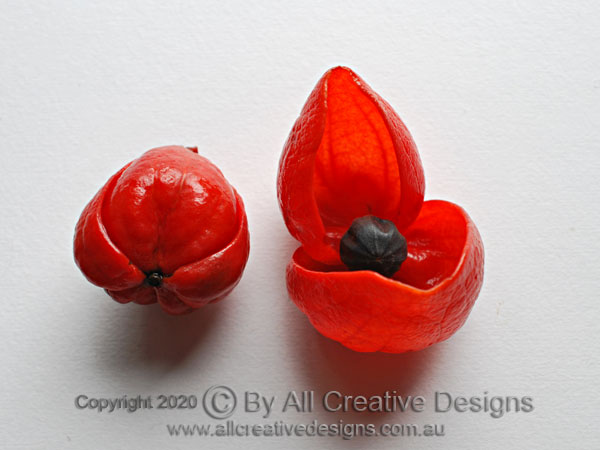
< Expand the Menu to access our Tree Identification Pages
Using Fruit Characteristics in the Identification of Australian Tree Species
We hope to raise the awareness to the high conservation value of remaining old growth forests in Australia. 'Trees might be a renewable resource, old growth forests are not'.
Descriptions, photos and illustrations copyright ©2024 by www.allcreativedesigns.com.au world wide rights reserved.
Click or Tap Images for Full Size View
Basic Types of Fruits
There is a major distinction between fleshy (succulent) and dry fruits. Fleshy fruits include berries and drupes, whereas capsules, pods or beans (legumes), samaras, achenes, nuts and follicles are classified as dry fruits. Normally fleshy fruits do not open or split and therefore are classified as being indehiscent. If a fruit opens/splits to disperse the seed it is classified as being dehiscent.
The outer layers that are derived from the ovary of a flower and surround the seed(s) of a fruit are referred to as a pericarp. For example, the pericarp of a drupe consists of a hard outer shell enclosing the seed (endocarp), a fleshy or mealy layer (mesocarp) and the outer skin (epicarp or exocarp).
Types of Fleshy & Indehiscent Fruits
A DRUPE: Usually a single seed encased in a hard woody shell (endocarp) surrounded by a fleshy or mealy layer (mesocarp) and a soft or sometimes leathery outer layer (epicarp). Some drupes contain up to 5 individual seeds.
The image shows the drupe of the Forest Maple (Cryptocarya rigida). Drupes are the typical fruit type of trees belonging to the Olive (OLEACEAE) and Laurel (LAURACEAE) families.
Click or Tap Images for Full Size View (opens new browser window)
A BERRY: Normally multiple seeds without a hard (woody) outer surface that are embedded throughout a fleshy or mealy pulp (mesocarp) and covered by a soft or leathery exterior (epicarp). Some berries only produce a single seed.
The image shows the berry of the widespread Kangaroo Apple (Solanum aviculare). The diverse genus of Solanum produces berries as a fruit and belongs to the family of Nightshades (SOLANACEAE).
A FIG: Numerous small seeds embedded within in a soft fleshy exterior, which is an enlarged receptacle, the uppermost part of a flower stalk. Usually floral parts are attached to the outer surface of a receptacle. Flowers situated within the receptacle are pollinated by tiny wasps, which gain access through a small opening at the apex, called an ostiole. See also multiple and accessory fruits on this page below.
There are about 40 fig trees (Ficus species) that are native to Australia.
View Fig tree species listed on this web site.
Rainforests of Australia's East Coast, HAND SIGNED BOOKS; (Out of Stock) A practical and informative field guide to the identification of native rainforest species. More than 800 colour photographs, informative graphics, maps and detailed description of more than 300 species.
This book is a valuable information source for bushwalkers, students, gardeners and anyone with an interest in Australia’s native flora.
The book was written and illustrated by the author of the tree identification web pages.
New Holland Publishers: May 2019
ISBN: 9781925546293
Format: Paperback with PVC
Pages: 304 pp.
Size: 23 cm high x 15 cm wide
Full Colour Photography
Rainforests: Identification - Evolution - Reproduction
Dedicated photography of rainforest species including; mosses, mushrooms, lichens, slime moulds, ferns, conifers, flowering trees, climbing plants, orchids and palms enable the reader to identify commonly encountered species.
CLICK HERE FOR MORE INFORMATION
Types of Dry & Dehiscent Fruits
A Follicle: Multiple seeds are contained in an undivided (unilocular) exterior (pericarp) that becomes typically hard or woody at full maturity before splitting along one side only to disperse the seeds. Seeds can be winged or (partly) covered by a papery layer.
Many prominent genera belonging to the Protea (PROTEACEAE) family, such as Grevillea, Banksia and Hakea produce woody follicles. The top image shows the woody follicle containing numerous tightly packed winged seeds of the Firewheel Tree (Stenocarpus sinuatus). The well-known Kurrajongs, including the Bottle Tree and Flame Tree, (Genus Brachychiton) produce large distinctive follicles.
The well-known Macadamia Nut Tree (Macadamia integrifolia) is a member of the PROTEA family (bottom image). It produces a follicle that splits along one side to release an edible seed encased in a hard woody shell, a nut. See nut characteristics below.
Click or Tap Images for Full Size View (opens new browser window)
A Pod or Legume: In contrast to a follicle a pod will split along both sides. Several to numerous seeds are normally sequentially arranged and attached to the inside of the pod by a stalk (funiculus), which can be somewhat fleshy (inset top left).
Trees and shrubs belonging to the Pea and Bean family (FABACEAE) include Wattles (Acacia species). The pod of the Cassia or Brush Senna (Senna acclinis) is shown.
Click or Tap Images for Full Size View (opens new browser window)
See Flower Characteristics Page and Leaf Characteristics Page or Bark Identification Page
Use the Key to Species, which employs leaf characteristics, to identify native trees and shrubs found on Australia's east coast.
A Capsule: This type of fruit features 2 or more separate chambers (valves) each containing one or several seeds. The exterior (pericarp) of some capsules splits into segments in order to release the seeds (A), whereas others disperse their seeds by open valve tips at the apex of the fruit (B).
The pericarps of some capsules are hard and woody, whereas the consistency of others can be soft and leathery.
The top image shows capsules of the Maiden’s Blush (Sloanea australis), which can feature from 2 to 5 separate valves (chambers) each containing a single seed that is covered in a red semi-fleshy layer called an aril [A].
The woody capsules of Flax-leaved Paperbark (Melaleuca linariifolia) [B] disperse their seeds by opening valve tips.
Fruits of Eucalyptus Trees: Eucalyptus trees produce a fruit with an exterior called a hypanthium that is not derived from the (flower) ovary wall, i.e. is not a pericarp. The hypanthium is a non-reproductive appendage joined to the receptacle which encapsulates the ovary and enlarges to form the often woody exterior of the fruit. The interior is divided into multiple valves (chambers) that disperse numerous seeds through opening valve tips. The bottom image shows the fruit of the Southern Mahogany (Eucalyptus botryoides). See Accessory Fruit (below on this page).
Click or Tap Images for Full Size View (opens new browser window)
Types of Dry & Indehiscent Fruits
1. Samara:
This distinctive fruit type consists normally of a single seed that is attached to a wing, allowing it to become airborne. Samaras are an uncommon type of fruit for Australian trees and shrubs. The tall rainforests trees referred to as Tulip Oaks and Booyongs (Argyrodendron species) bear samaras more than 6cm long. Other types of fruits such as capsules can feature wings.
2. Nut:
A nut is described as a dry indehiscent fruit that produces a single seed encased within a hard woody shell. Normally the seed is free of the inside shell when the fruit is fully ripe. The Candlenut (Aleurites moluccana) is a tree species native to Northern Queensland that produces a nut (shown). The Australian Beeches (Notofagus species) produce 3 nuts (inset image 2) that are enclosed in an enlarged cupule. (A cupule is a non-reproductive part of a flower that persists and enlarges to encase the actual fruit derived from the ovary).
3. Achene:
Achenes are dry, indehiscent, small single seeded fruits. The fruit wall (pericarp) is usually rather thin and papery, and the seed is not fused to the inside wall. Species belonging to the Daisy family (ASTERACEAE) produce an achene that is typically crowned by a pappus, a tuft of feathery hair. The diverse genus of Daisy Bushes (Olearia in family ASTERACEAE) includes woody shrubs (less than 4m tall) that produce achenes but the Musk Daisy Bush (Olearia argophylla) is the only species to reach the height of a small tree.
Click or Tap Image for Full Size View
Ramiflorous and Cauliflorous Fruit
The majority of trees and shrubs bear fruit along younger branches and/or in terminal positions (at the very end of branchlets).
Image 1 shows the fruit (capsules) of the Fine-leaved Tuckeroo (Lepiderema pulchella), bearing fruit along young branches.
A number of trees produce fruit along older branches (limbs), an attribute referred to as ramiflorous. Trees which regularly bear fruit on the trunk are called cauliflorous. Some trees have both characteristics.
Image 2 shows the Creek Sandpaper Fig (Ficus coronata), which produces fruit (figs) along young branches, limbs and on the trunk.
Image 3 shows the cauliflorous fruit on the trunk of the White Apple (Syzygium cormiflorum).
Click or Tap Image for Full Size View
green guide TREES OF AUSTRALIA
How to recognise Australian tree families and genera.
A practical field guide to the identification of native species. More than 200 full colour photographs and detailed descriptions explaining leaf, bark, flower, fruit and other tree characteristics. The guide was written and illustrated by the author of these web pages.
New Holland Publishers: January 2016
Format: Paperback with PVC
Pages: 128 pp.
Size: 13 cm wide x 18 cm high
First Edition, Hand Signed Copies
CLICK HERE FOR MORE INFORMATION Simple, Aggregate, Multiple and Accessory Fruits
Fruit of flowering trees and shrubs (Angiosperms) are the product of a carpel, the female reproductive organ of a flower that typically consists of an ovary, style and stigma. The ovary can contain one or multiple ovules (egg cells), which produce the seed(s). View the Tree Identification
using Flower Characteristics Page for more information. Botanically, fruits are assigned to 4 different categories depending on the flower structure from which they derived: Simple, Aggregate, Multiple and Accessory Fruits.
Simple Fruits
Simple Fruits: develop from a single flower with a single (simple) carpel or fused carpel (pistil).
See Flower Characteristics Page for information.
Drupes are typically derived from a single flower with a single carpel and contain mostly only one seed (rarely 2 to 5).
Image (1) depicts the flower of the Pink Walnut (Endiandra sieberi) and
Image (2) shows
the derived drupe. Some species produce drupes that are part of an aggregate fruit, see below.
Capsules are derived from a single flower with a fused carpel (pistil) that produces 2 or more separate chambers (valves), each containing one or several seeds.
Image (3) shows the flower of the Brush Teak (Toechima tenax) and the developing ovary is shown in inset (3).
Image (4) depicts the derived fruit of the Brush Teak, a 2-valved capsule..
Berries are derived of a single carpel or fused carpel (syncarpous) of a single flower. Some berries only produce a single seed, but the majority of berries contain many seeds.
Legumes are derived from a single flower with a single carpel and typically produce multiple seeds.
Follicles can be the product of a single flower with a single carpel or the product of a single flower with multiple free (unfused) carpels. See aggregate fruits below.
Click or Tap Image for Full Size View
Aggregate Fruits
Aggregate Fruits: derive from a single flower with multiple free carpels.
The best known aggregate fruits are the raspberry and blackberry (Rubus species).
Image (1) shows the single flower with many crowded free carpels and the derived aggregate fruit consisting of multiple small drupes of the Native Raspberry (Rubus rosifolius). Individual drupes are referred to as drupelets, which are attached to the enlarged flower receptacle. The genus Rubus contains a number of native straggly shrubs and climbing plants (vines).
Image (2) shows the aggregate fruit of the Veiny Wilkiea (Wilkiea huegeliana), with multiple drupelets attached to the enlarged flower receptacle. The genus Wilkiea comprises a number of native woody shrubs and small trees.
Image (3) shows the female flower with 5 free carpels of the Bottle Tree (Brachychiton rupestris). Individual carpels are stalked.
Image (4) shows the maximum 5 (Brachychiton) follicles derived from the single flower. The genus Brachychiton includes well-known trees such as the Flame Tree and Kurrajongs.
Aggregate fruits are relatively uncommon for Australian trees and shrubs.
Click or Tap Image for Full Size View
Multiple Fruits
Multiple Fruits: develop from the carpels of multiple flowers forming a cluster..
Image (1) shows a flower cluster of the Noni or Cheese Fruit Tree (Morinda citrifolia).
Image (2) shows the derived fruit.
Image (3) shows the flowers of the Turpentine Tree (Syncarpia glomulifera) forming a tight cluster.
Image (4) shows the multiple fruit derived from a cluster of up to 8 individual flowers.
Fig trees (Ficus species) create a multiple fruit consisting of masses of minute individual flowers that are located on the inside of an enlarged (flower) receptacle, i.e. a multiple fruit with accessory qualities.
Click or Tap Image for Full Size View
Accessory Fruits
Accessory Fruits: incorporate other than female reproductive floral components into the structure of the fruit, i.e. parts of the fruit are not derived from the ovary. Accessory fruits are also known as false fruits. Accessory fruit are categorised depending on which type of floral components are part of the mature fruit.
1. A perianth is the collective term for the non-reproductive sepals and petals of a flower. The fruit exterior of the Birdlime Tree (Pisonia umbellifera) is formed by the persistent perianth, also called an anthocarp. Image (1) depicts the ripe fruit and the image inset the flower.
2. A hypanthium is a cup/cone-shaped or more tubular extension of the flower receptacle that surrounds the ovary and to which sepals, petals and stamens are connected. The fruit of Eucalyptus trees is encapsulated in the enlarged and normally hardened (woody) hypanthium, i.e. the exterior of the fruit is not derived from the ovary. Image (2) shows the fruit of the Blue Gum (Eucalyptus saligna) and its flower is shown in the inset.
3. A receptacle is the uppermost portion of the flower stalk to which floral components are usually externally attached to. In contrast, fig trees produce masses of fleshy flowers that are contained within a swollen receptacle, i.e. the outside layer of a fig fruit (syconium) is not derived from an ovary and the interior of the fruit is produced by multiple flowers growing in a cluster (a multiple fruit).
4. A calyx is formed by sepals, which can be free (separated) or can be fused together (normally cup-, cone- or tube-shaped). Trees belonging to the genus of Syzygium, commonly known as Lilly Pillies and Satinashes, produce a fruit that often incorporates the calyx at the apex.
Click or Tap Image for Full Size View
Bracts & Cupules
Enlarged and persistent non-reproductive floral components that are part of a ripened fruit include bracts or cupules, which are defined as leaf-like appendages (modified leaves) that are attached to a solitary flower or compound flower arrangement, inflorescence.
The image to the right shows the bright red and fleshy bracts surrounding the ripe fruit of the Grease Nut Tree (Hernandia bivalvis).
Click or Tap Image for Full Size View
